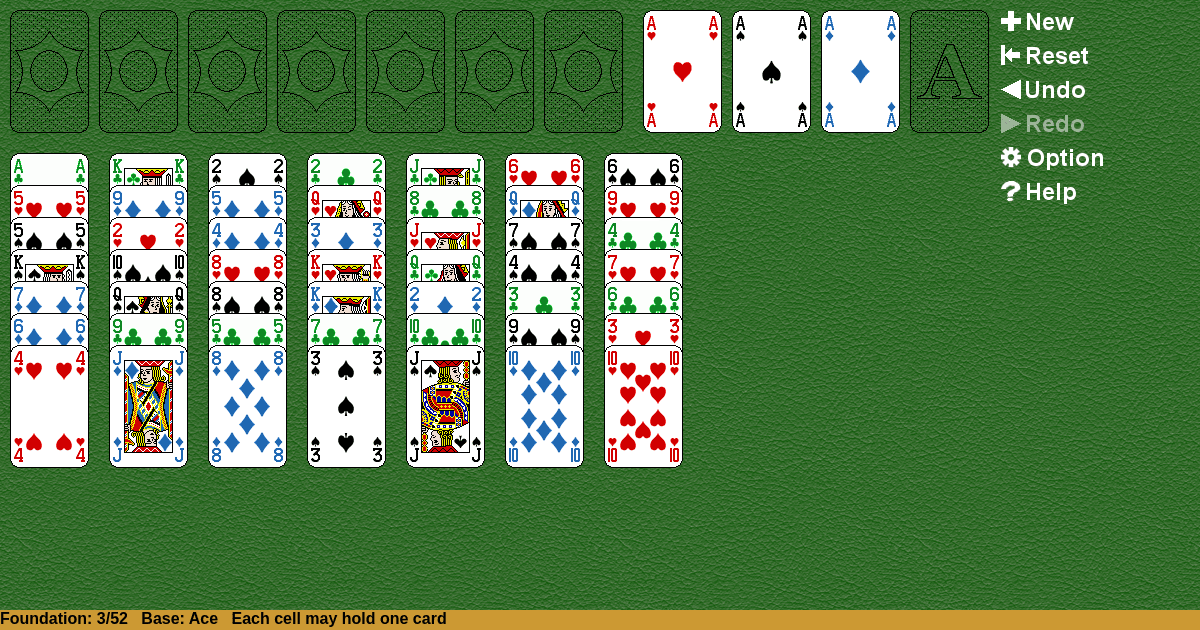Penguin
Home |
How to play |
FAQ |
About
How to play Penguin?
Game Objective
The primary goal of Penguin Solitaire is to move all 52 cards from a standard deck into the foundation piles, building each foundation in ascending sequence and by suit, from a randomly determined starting rank up to the rank just below the starting rank, wrapping from King to Ace as necessary. Successfully building all four foundations to 13 cards each results in a win.
Setup & Layout
- Deck: Use one standard 52-card deck.
- Tableau: Deal 49 cards face-up into seven columns (tableaus), each containing seven cards. All cards are visible from the start, making this a game of perfect information.
- Foundations: Four foundation piles are used. The first card dealt (called the beak) determines the starting rank for all foundations. As you deal, place the other three cards of this rank aside as the initial foundations. The fourth card of this rank (the beak) remains at the bottom of the first tableau column until it can be moved to start the fourth foundation.
- Reserve (Flipper): Seven empty cells (reserves) are placed above the tableau. These act as temporary holding spaces for any single card during play.
- Initial State: At setup, three foundations are started (each with one card of the beak’s rank), the fourth foundation is empty (awaiting the beak), the tableau is fully dealt face-up, and the flipper is empty.
Penguin Solitaire Rules
Fundamental Principles
- Foundations: Build up in suit, starting from the beak’s rank and continuing in sequence (e.g., if the beak is a 10, the sequence is 10-J-Q-K-A-2-3-4-5-6-7-8-9, wrapping from King to Ace).
- Tableau: Build down in the same suit. For example, a 7 of Hearts can only be placed on an 8 of Hearts.
- Movement: Only the bottom card of each tableau column is available for play. You may move this card to a foundation (if it fits the sequence), to an empty cell in the flipper, or to the bottom of another tableau column to continue a downward suit-sequence.
- Sequences: You may move a sequence of cards from the bottom of a column if they form an unbroken downward suit-sequence. The entire sequence can be moved as a unit to another column if the join continues the sequence.
- Flipper: Any single card from the tableau or flipper can be moved to an empty cell in the flipper at any time. Cards in the flipper can be moved to foundations or tableau columns as appropriate.
Building Sequences
- Foundations: Always build up in suit, starting from the beak’s rank. The sequence is cyclical (e.g., after King comes Ace, then 2, etc.).
- Tableau: Always build down in the same suit. No alternating colors or suits are allowed.
- Empty Columns: An empty tableau column can only be filled by a card (or sequence headed by a card) that is one rank below the foundation starting rank. For example, if the foundation starts with a 10, only a 9 can start a new column. If the foundation starts with an Ace, only a King can start a new column.
Gameplay
- Initial Moves: Survey the tableau for cards that can be moved to foundations or flipper. Prioritize freeing the beak from the first column to start the fourth foundation.
- Building Foundations: As cards become available, move them to the appropriate foundation pile in ascending suit sequence.
- Tableau Management: Use the flipper to temporarily hold cards, allowing you to access cards beneath them in the tableau. Move sequences between columns to free up cards needed for foundations.
- Sequence Moves: When possible, move entire sequences of cards from the bottom of one column to another to continue building downward in suit.
- No New Cards: All cards are dealt at the start; there is no stock or waste pile. Play continues until no more legal moves are possible.
- Stalemate: If no more cards can be moved to foundations and no further tableau or flipper moves are possible, the game is lost.
Winning & Losing Conditions
- Winning: Move all 52 cards to the four foundation piles, each built up in suit from the starting rank to the rank just below, wrapping as necessary. All foundations must contain 13 cards.
- Losing: The game is lost if no more legal moves are possible and not all cards have been moved to the foundations.
Special Rules & Edge Cases
- Empty Columns: Only a card (or sequence headed by a card) that is one rank below the foundation starting rank can fill an empty tableau column.
- Supermove: Some digital versions allow “supermoves,” where you can move multiple cards at once if the move would be valid for each individual card. However, this is not universal and may have implementation-specific limitations.
- Perfect Information: Since all cards are face-up from the start, Penguin Solitaire is a game of maximum skill and planning.
- No Redeal: There is no reshuffling or redeal; all play occurs with the initial layout.
- Flipper Usage: The flipper is a critical strategic tool. Use it to temporarily park cards and access deeper tableau cards, but remember that only one card can occupy each flipper cell at a time.
Summary Table: Key Play Areas
| Area | Description | Cards Face-Up? | Purpose | |-------------|-----------------------------------------------------------------------------|----------------|------------------------------------------| | Tableau | 7 columns, 7 cards each (49 total) | Yes | Build down in suit, free cards for foundations | | Foundations | 4 piles | Yes | Build up in suit from starting rank | | Flipper | 7 single-card reserves | Yes | Temporary holding for any single card |
Penguin Solitaire is a challenging, strategic solitaire variant that rewards careful planning and sequence management. Its unique starting layout, cyclical foundation building, and use of reserve cells distinguish it from more common solitaire games.




























































